Contemporary Leadership Evolution: A Study of Changes from 2000-2019
VerifiedAdded on 2023/03/31
|6
|1340
|427
Essay
AI Summary
This essay evaluates the significant changes in leadership between 2000 and 2019, focusing on how globalization, technological advancements, and societal expectations have reshaped leadership styles. The paper examines the leadership approaches of Bill Gates, former chairman of Microsoft, and Reed Hastings, CEO of Netflix, as case studies. It highlights the shift from solely profit-driven strategies to a focus on corporate social responsibility, employee management, diversity, and innovation. The analysis covers topics such as sustainability policies, employee retention strategies, and the adoption of decentralized decision-making models. The essay emphasizes the importance of these changes for leaders navigating today's competitive business environment and achieving sustainable growth and competitive advantage. The examples of Microsoft and Netflix illustrate how leaders can adapt to these evolving demands, fostering innovation and maintaining a positive relationship with employees.
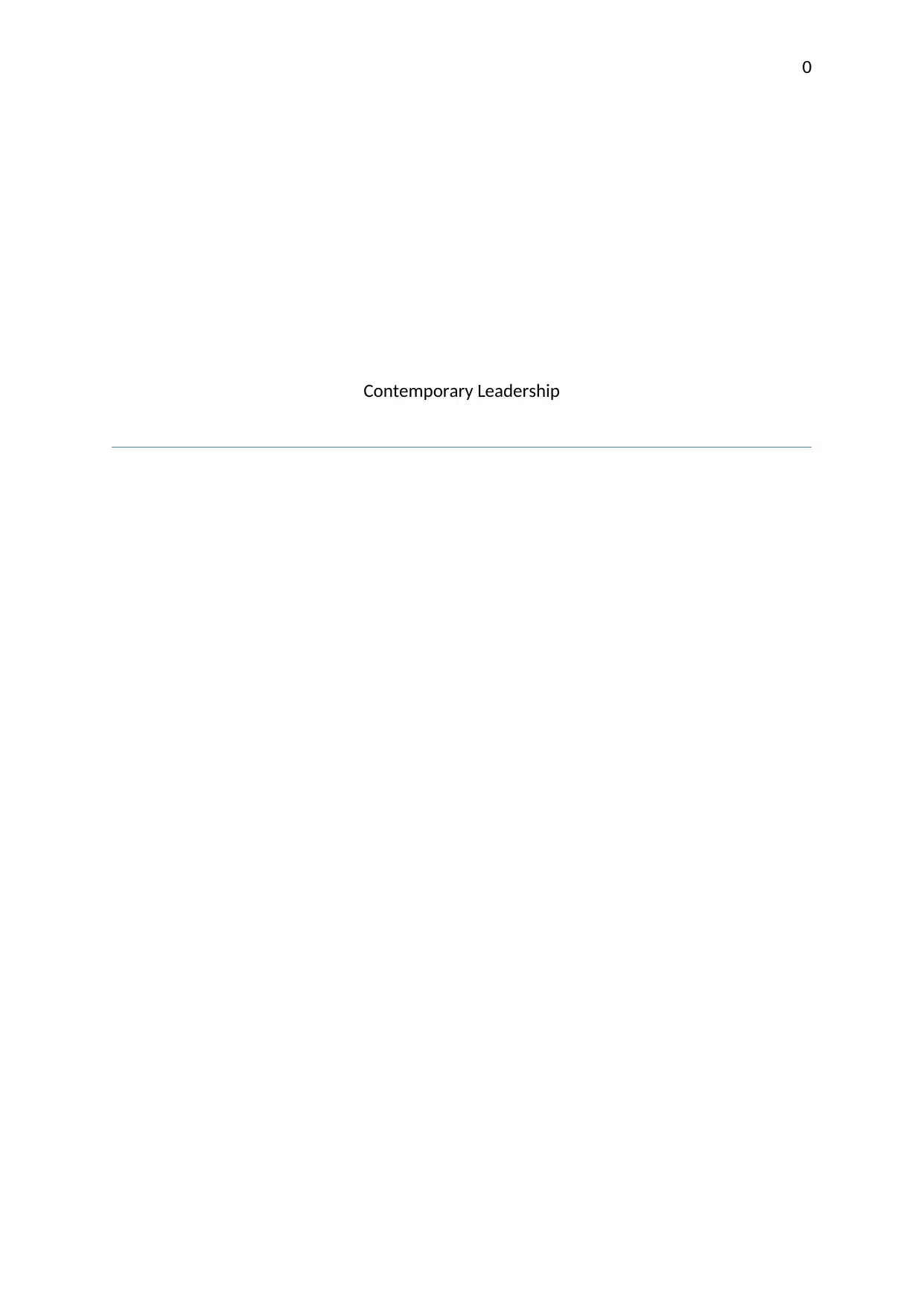
0
Contemporary Leadership
Contemporary Leadership
Paraphrase This Document
Need a fresh take? Get an instant paraphrase of this document with our AI Paraphraser
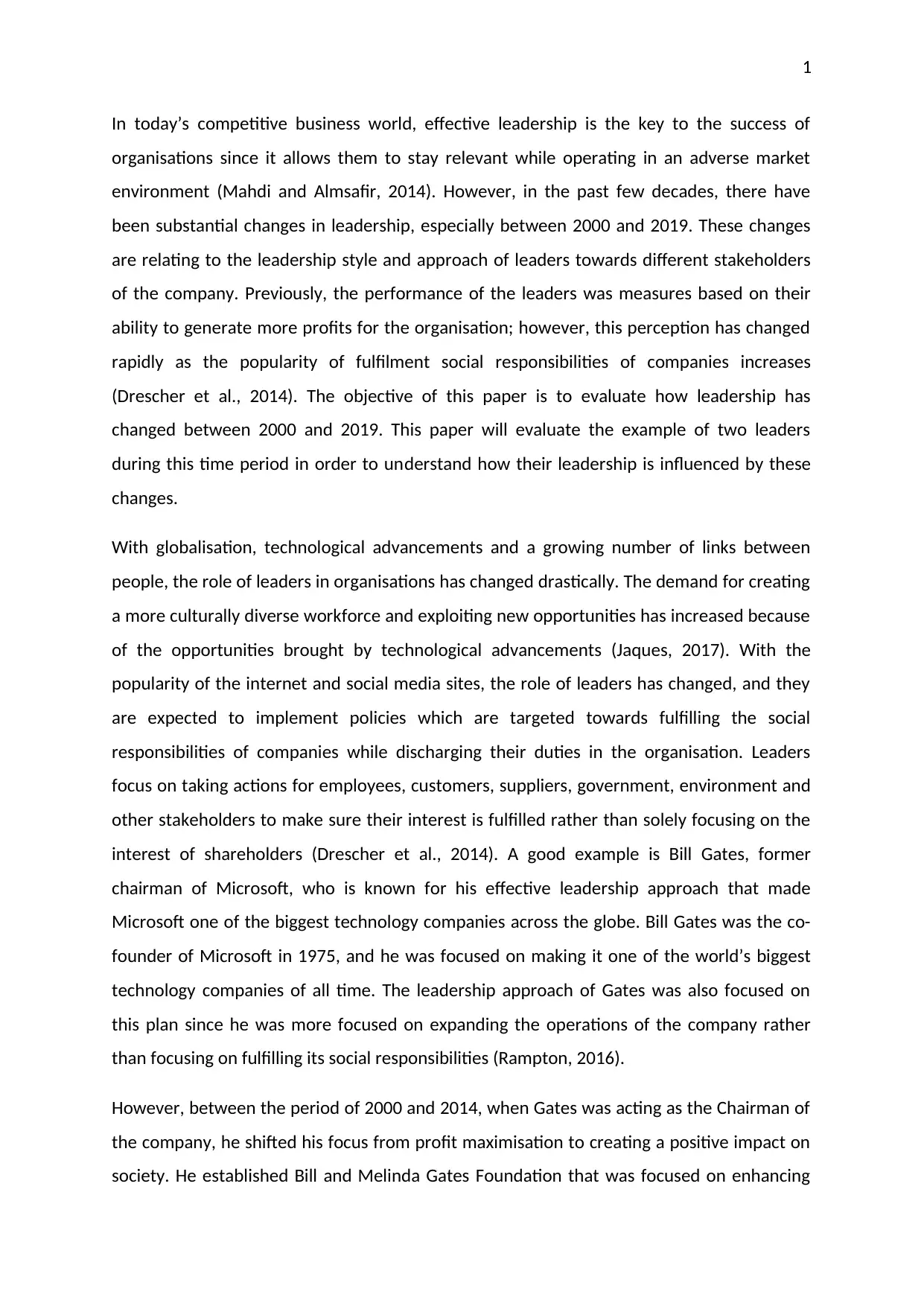
1
In today’s competitive business world, effective leadership is the key to the success of
organisations since it allows them to stay relevant while operating in an adverse market
environment (Mahdi and Almsafir, 2014). However, in the past few decades, there have
been substantial changes in leadership, especially between 2000 and 2019. These changes
are relating to the leadership style and approach of leaders towards different stakeholders
of the company. Previously, the performance of the leaders was measures based on their
ability to generate more profits for the organisation; however, this perception has changed
rapidly as the popularity of fulfilment social responsibilities of companies increases
(Drescher et al., 2014). The objective of this paper is to evaluate how leadership has
changed between 2000 and 2019. This paper will evaluate the example of two leaders
during this time period in order to understand how their leadership is influenced by these
changes.
With globalisation, technological advancements and a growing number of links between
people, the role of leaders in organisations has changed drastically. The demand for creating
a more culturally diverse workforce and exploiting new opportunities has increased because
of the opportunities brought by technological advancements (Jaques, 2017). With the
popularity of the internet and social media sites, the role of leaders has changed, and they
are expected to implement policies which are targeted towards fulfilling the social
responsibilities of companies while discharging their duties in the organisation. Leaders
focus on taking actions for employees, customers, suppliers, government, environment and
other stakeholders to make sure their interest is fulfilled rather than solely focusing on the
interest of shareholders (Drescher et al., 2014). A good example is Bill Gates, former
chairman of Microsoft, who is known for his effective leadership approach that made
Microsoft one of the biggest technology companies across the globe. Bill Gates was the co-
founder of Microsoft in 1975, and he was focused on making it one of the world’s biggest
technology companies of all time. The leadership approach of Gates was also focused on
this plan since he was more focused on expanding the operations of the company rather
than focusing on fulfilling its social responsibilities (Rampton, 2016).
However, between the period of 2000 and 2014, when Gates was acting as the Chairman of
the company, he shifted his focus from profit maximisation to creating a positive impact on
society. He established Bill and Melinda Gates Foundation that was focused on enhancing
In today’s competitive business world, effective leadership is the key to the success of
organisations since it allows them to stay relevant while operating in an adverse market
environment (Mahdi and Almsafir, 2014). However, in the past few decades, there have
been substantial changes in leadership, especially between 2000 and 2019. These changes
are relating to the leadership style and approach of leaders towards different stakeholders
of the company. Previously, the performance of the leaders was measures based on their
ability to generate more profits for the organisation; however, this perception has changed
rapidly as the popularity of fulfilment social responsibilities of companies increases
(Drescher et al., 2014). The objective of this paper is to evaluate how leadership has
changed between 2000 and 2019. This paper will evaluate the example of two leaders
during this time period in order to understand how their leadership is influenced by these
changes.
With globalisation, technological advancements and a growing number of links between
people, the role of leaders in organisations has changed drastically. The demand for creating
a more culturally diverse workforce and exploiting new opportunities has increased because
of the opportunities brought by technological advancements (Jaques, 2017). With the
popularity of the internet and social media sites, the role of leaders has changed, and they
are expected to implement policies which are targeted towards fulfilling the social
responsibilities of companies while discharging their duties in the organisation. Leaders
focus on taking actions for employees, customers, suppliers, government, environment and
other stakeholders to make sure their interest is fulfilled rather than solely focusing on the
interest of shareholders (Drescher et al., 2014). A good example is Bill Gates, former
chairman of Microsoft, who is known for his effective leadership approach that made
Microsoft one of the biggest technology companies across the globe. Bill Gates was the co-
founder of Microsoft in 1975, and he was focused on making it one of the world’s biggest
technology companies of all time. The leadership approach of Gates was also focused on
this plan since he was more focused on expanding the operations of the company rather
than focusing on fulfilling its social responsibilities (Rampton, 2016).
However, between the period of 2000 and 2014, when Gates was acting as the Chairman of
the company, he shifted his focus from profit maximisation to creating a positive impact on
society. He established Bill and Melinda Gates Foundation that was focused on enhancing
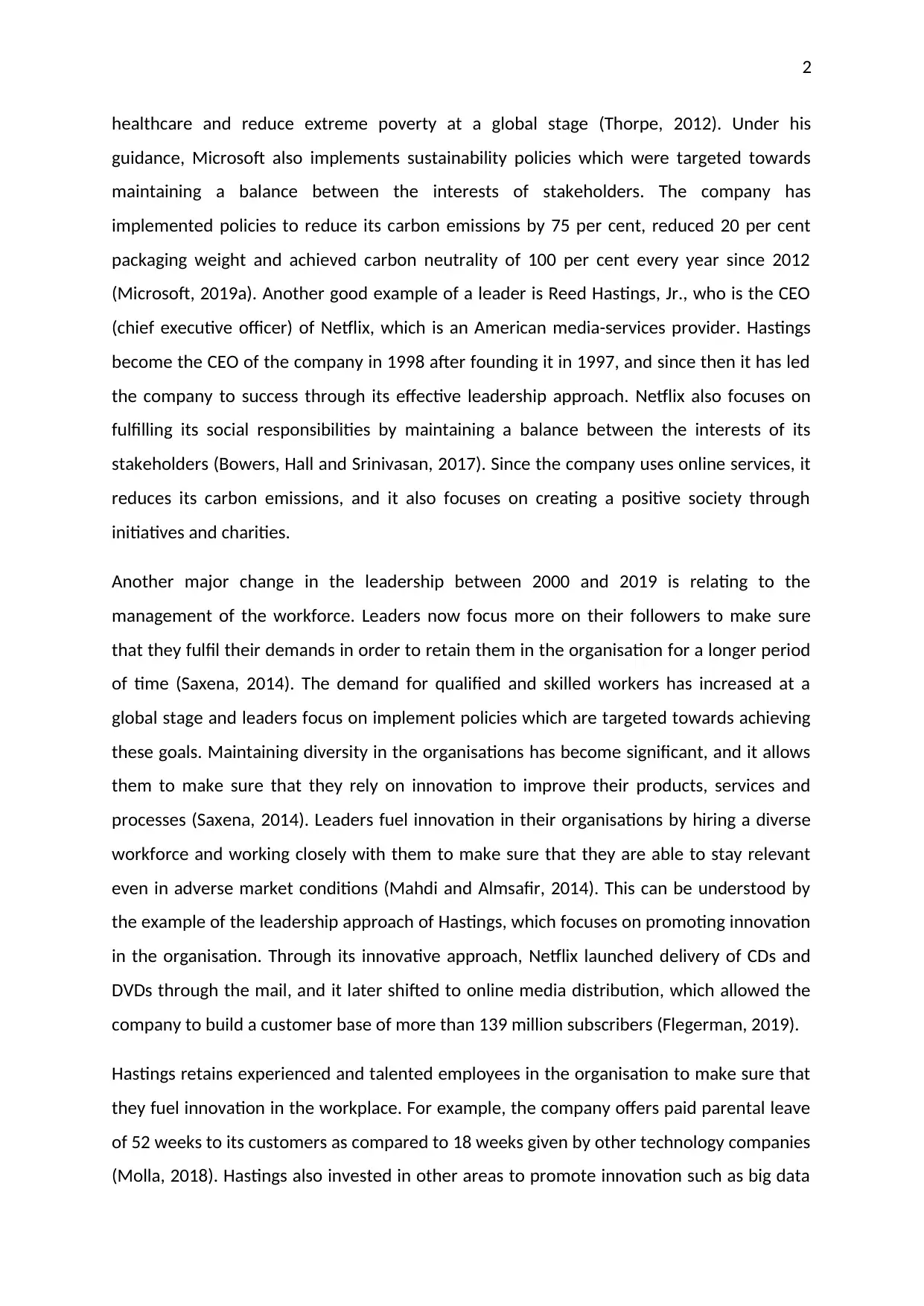
2
healthcare and reduce extreme poverty at a global stage (Thorpe, 2012). Under his
guidance, Microsoft also implements sustainability policies which were targeted towards
maintaining a balance between the interests of stakeholders. The company has
implemented policies to reduce its carbon emissions by 75 per cent, reduced 20 per cent
packaging weight and achieved carbon neutrality of 100 per cent every year since 2012
(Microsoft, 2019a). Another good example of a leader is Reed Hastings, Jr., who is the CEO
(chief executive officer) of Netflix, which is an American media-services provider. Hastings
become the CEO of the company in 1998 after founding it in 1997, and since then it has led
the company to success through its effective leadership approach. Netflix also focuses on
fulfilling its social responsibilities by maintaining a balance between the interests of its
stakeholders (Bowers, Hall and Srinivasan, 2017). Since the company uses online services, it
reduces its carbon emissions, and it also focuses on creating a positive society through
initiatives and charities.
Another major change in the leadership between 2000 and 2019 is relating to the
management of the workforce. Leaders now focus more on their followers to make sure
that they fulfil their demands in order to retain them in the organisation for a longer period
of time (Saxena, 2014). The demand for qualified and skilled workers has increased at a
global stage and leaders focus on implement policies which are targeted towards achieving
these goals. Maintaining diversity in the organisations has become significant, and it allows
them to make sure that they rely on innovation to improve their products, services and
processes (Saxena, 2014). Leaders fuel innovation in their organisations by hiring a diverse
workforce and working closely with them to make sure that they are able to stay relevant
even in adverse market conditions (Mahdi and Almsafir, 2014). This can be understood by
the example of the leadership approach of Hastings, which focuses on promoting innovation
in the organisation. Through its innovative approach, Netflix launched delivery of CDs and
DVDs through the mail, and it later shifted to online media distribution, which allowed the
company to build a customer base of more than 139 million subscribers (Flegerman, 2019).
Hastings retains experienced and talented employees in the organisation to make sure that
they fuel innovation in the workplace. For example, the company offers paid parental leave
of 52 weeks to its customers as compared to 18 weeks given by other technology companies
(Molla, 2018). Hastings also invested in other areas to promote innovation such as big data
healthcare and reduce extreme poverty at a global stage (Thorpe, 2012). Under his
guidance, Microsoft also implements sustainability policies which were targeted towards
maintaining a balance between the interests of stakeholders. The company has
implemented policies to reduce its carbon emissions by 75 per cent, reduced 20 per cent
packaging weight and achieved carbon neutrality of 100 per cent every year since 2012
(Microsoft, 2019a). Another good example of a leader is Reed Hastings, Jr., who is the CEO
(chief executive officer) of Netflix, which is an American media-services provider. Hastings
become the CEO of the company in 1998 after founding it in 1997, and since then it has led
the company to success through its effective leadership approach. Netflix also focuses on
fulfilling its social responsibilities by maintaining a balance between the interests of its
stakeholders (Bowers, Hall and Srinivasan, 2017). Since the company uses online services, it
reduces its carbon emissions, and it also focuses on creating a positive society through
initiatives and charities.
Another major change in the leadership between 2000 and 2019 is relating to the
management of the workforce. Leaders now focus more on their followers to make sure
that they fulfil their demands in order to retain them in the organisation for a longer period
of time (Saxena, 2014). The demand for qualified and skilled workers has increased at a
global stage and leaders focus on implement policies which are targeted towards achieving
these goals. Maintaining diversity in the organisations has become significant, and it allows
them to make sure that they rely on innovation to improve their products, services and
processes (Saxena, 2014). Leaders fuel innovation in their organisations by hiring a diverse
workforce and working closely with them to make sure that they are able to stay relevant
even in adverse market conditions (Mahdi and Almsafir, 2014). This can be understood by
the example of the leadership approach of Hastings, which focuses on promoting innovation
in the organisation. Through its innovative approach, Netflix launched delivery of CDs and
DVDs through the mail, and it later shifted to online media distribution, which allowed the
company to build a customer base of more than 139 million subscribers (Flegerman, 2019).
Hastings retains experienced and talented employees in the organisation to make sure that
they fuel innovation in the workplace. For example, the company offers paid parental leave
of 52 weeks to its customers as compared to 18 weeks given by other technology companies
(Molla, 2018). Hastings also invested in other areas to promote innovation such as big data
⊘ This is a preview!⊘
Do you want full access?
Subscribe today to unlock all pages.

Trusted by 1+ million students worldwide
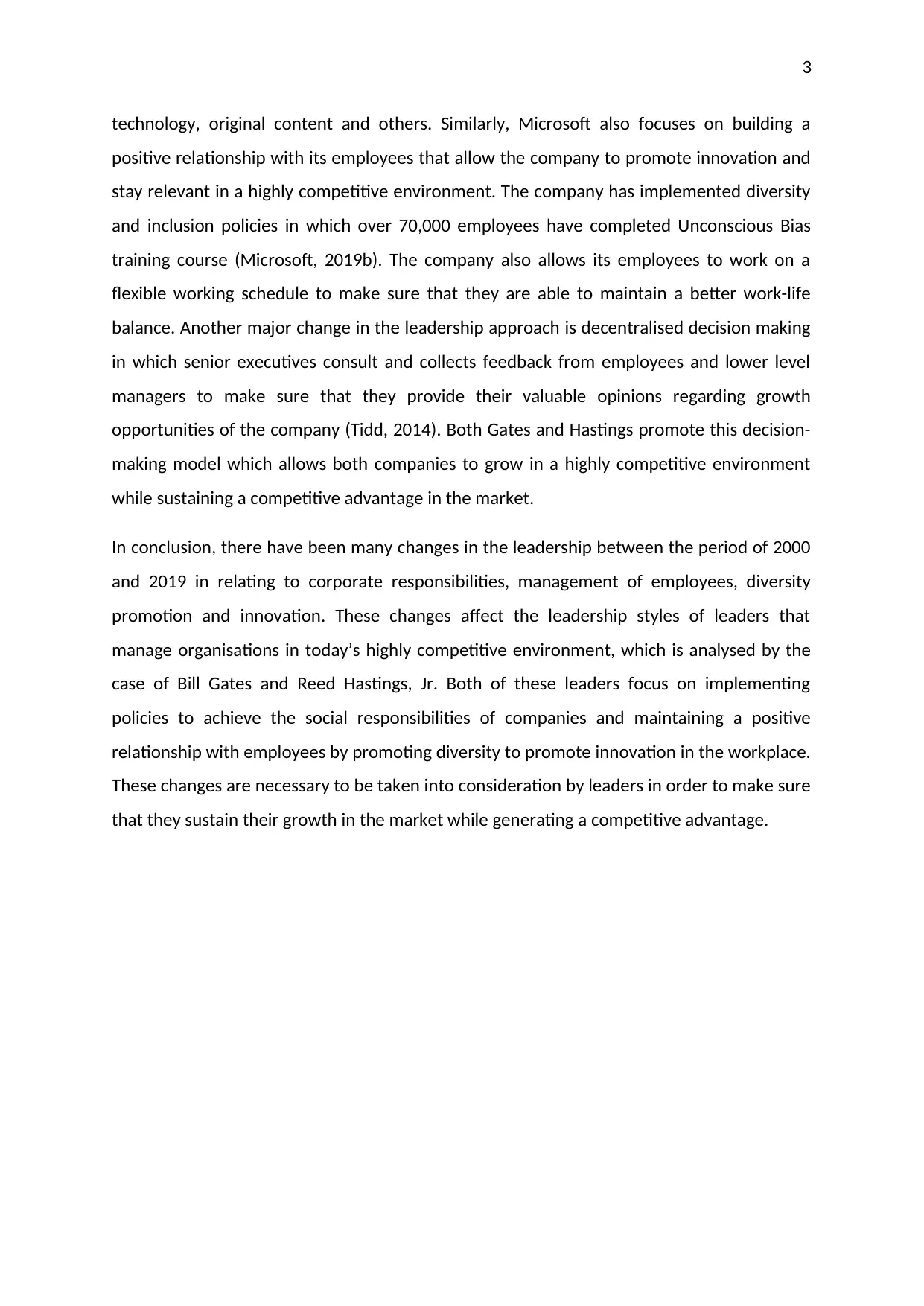
3
technology, original content and others. Similarly, Microsoft also focuses on building a
positive relationship with its employees that allow the company to promote innovation and
stay relevant in a highly competitive environment. The company has implemented diversity
and inclusion policies in which over 70,000 employees have completed Unconscious Bias
training course (Microsoft, 2019b). The company also allows its employees to work on a
flexible working schedule to make sure that they are able to maintain a better work-life
balance. Another major change in the leadership approach is decentralised decision making
in which senior executives consult and collects feedback from employees and lower level
managers to make sure that they provide their valuable opinions regarding growth
opportunities of the company (Tidd, 2014). Both Gates and Hastings promote this decision-
making model which allows both companies to grow in a highly competitive environment
while sustaining a competitive advantage in the market.
In conclusion, there have been many changes in the leadership between the period of 2000
and 2019 in relating to corporate responsibilities, management of employees, diversity
promotion and innovation. These changes affect the leadership styles of leaders that
manage organisations in today’s highly competitive environment, which is analysed by the
case of Bill Gates and Reed Hastings, Jr. Both of these leaders focus on implementing
policies to achieve the social responsibilities of companies and maintaining a positive
relationship with employees by promoting diversity to promote innovation in the workplace.
These changes are necessary to be taken into consideration by leaders in order to make sure
that they sustain their growth in the market while generating a competitive advantage.
technology, original content and others. Similarly, Microsoft also focuses on building a
positive relationship with its employees that allow the company to promote innovation and
stay relevant in a highly competitive environment. The company has implemented diversity
and inclusion policies in which over 70,000 employees have completed Unconscious Bias
training course (Microsoft, 2019b). The company also allows its employees to work on a
flexible working schedule to make sure that they are able to maintain a better work-life
balance. Another major change in the leadership approach is decentralised decision making
in which senior executives consult and collects feedback from employees and lower level
managers to make sure that they provide their valuable opinions regarding growth
opportunities of the company (Tidd, 2014). Both Gates and Hastings promote this decision-
making model which allows both companies to grow in a highly competitive environment
while sustaining a competitive advantage in the market.
In conclusion, there have been many changes in the leadership between the period of 2000
and 2019 in relating to corporate responsibilities, management of employees, diversity
promotion and innovation. These changes affect the leadership styles of leaders that
manage organisations in today’s highly competitive environment, which is analysed by the
case of Bill Gates and Reed Hastings, Jr. Both of these leaders focus on implementing
policies to achieve the social responsibilities of companies and maintaining a positive
relationship with employees by promoting diversity to promote innovation in the workplace.
These changes are necessary to be taken into consideration by leaders in order to make sure
that they sustain their growth in the market while generating a competitive advantage.
Paraphrase This Document
Need a fresh take? Get an instant paraphrase of this document with our AI Paraphraser
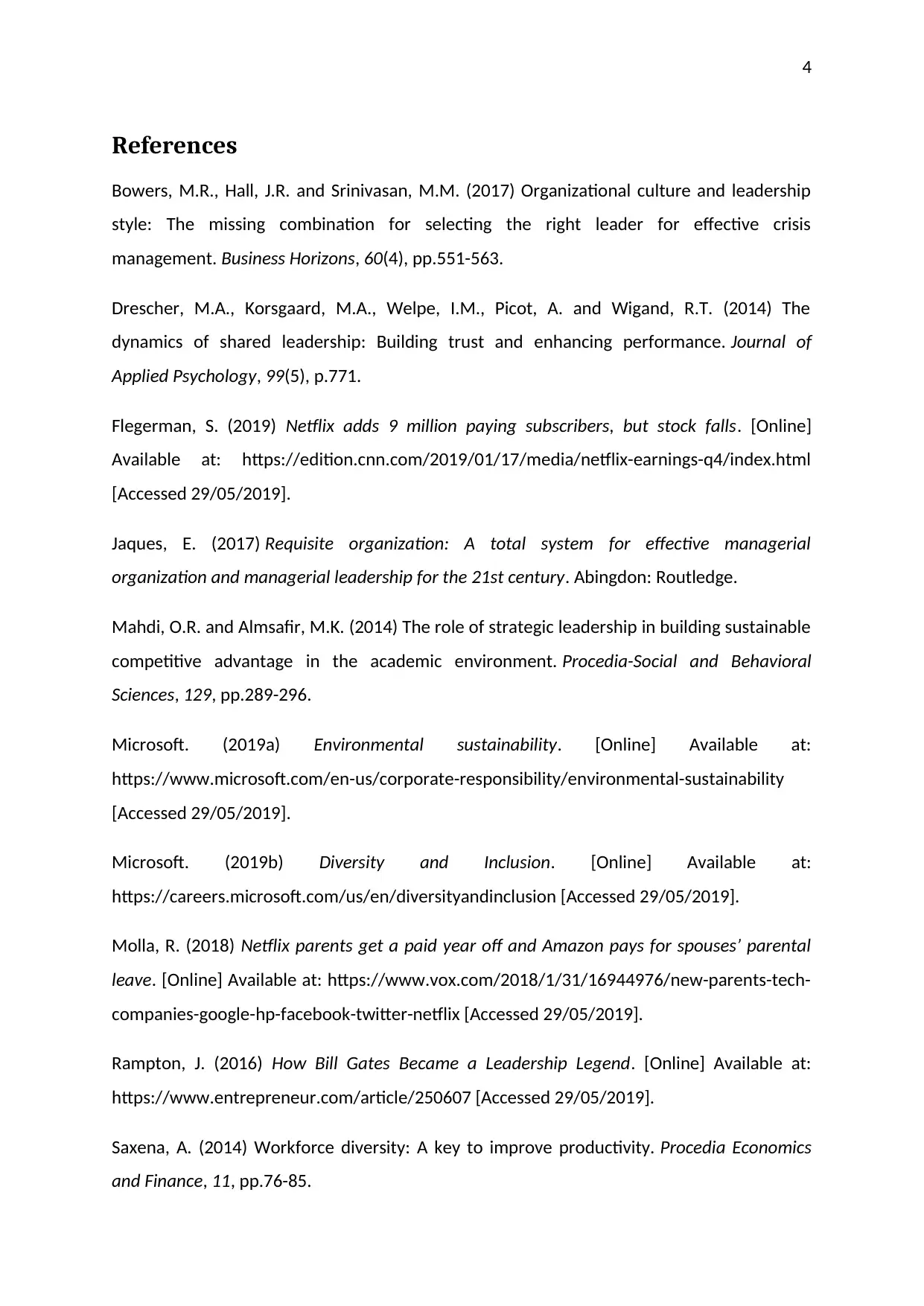
4
References
Bowers, M.R., Hall, J.R. and Srinivasan, M.M. (2017) Organizational culture and leadership
style: The missing combination for selecting the right leader for effective crisis
management. Business Horizons, 60(4), pp.551-563.
Drescher, M.A., Korsgaard, M.A., Welpe, I.M., Picot, A. and Wigand, R.T. (2014) The
dynamics of shared leadership: Building trust and enhancing performance. Journal of
Applied Psychology, 99(5), p.771.
Flegerman, S. (2019) Netflix adds 9 million paying subscribers, but stock falls. [Online]
Available at: https://edition.cnn.com/2019/01/17/media/netflix-earnings-q4/index.html
[Accessed 29/05/2019].
Jaques, E. (2017) Requisite organization: A total system for effective managerial
organization and managerial leadership for the 21st century. Abingdon: Routledge.
Mahdi, O.R. and Almsafir, M.K. (2014) The role of strategic leadership in building sustainable
competitive advantage in the academic environment. Procedia-Social and Behavioral
Sciences, 129, pp.289-296.
Microsoft. (2019a) Environmental sustainability. [Online] Available at:
https://www.microsoft.com/en-us/corporate-responsibility/environmental-sustainability
[Accessed 29/05/2019].
Microsoft. (2019b) Diversity and Inclusion. [Online] Available at:
https://careers.microsoft.com/us/en/diversityandinclusion [Accessed 29/05/2019].
Molla, R. (2018) Netflix parents get a paid year off and Amazon pays for spouses’ parental
leave. [Online] Available at: https://www.vox.com/2018/1/31/16944976/new-parents-tech-
companies-google-hp-facebook-twitter-netflix [Accessed 29/05/2019].
Rampton, J. (2016) How Bill Gates Became a Leadership Legend. [Online] Available at:
https://www.entrepreneur.com/article/250607 [Accessed 29/05/2019].
Saxena, A. (2014) Workforce diversity: A key to improve productivity. Procedia Economics
and Finance, 11, pp.76-85.
References
Bowers, M.R., Hall, J.R. and Srinivasan, M.M. (2017) Organizational culture and leadership
style: The missing combination for selecting the right leader for effective crisis
management. Business Horizons, 60(4), pp.551-563.
Drescher, M.A., Korsgaard, M.A., Welpe, I.M., Picot, A. and Wigand, R.T. (2014) The
dynamics of shared leadership: Building trust and enhancing performance. Journal of
Applied Psychology, 99(5), p.771.
Flegerman, S. (2019) Netflix adds 9 million paying subscribers, but stock falls. [Online]
Available at: https://edition.cnn.com/2019/01/17/media/netflix-earnings-q4/index.html
[Accessed 29/05/2019].
Jaques, E. (2017) Requisite organization: A total system for effective managerial
organization and managerial leadership for the 21st century. Abingdon: Routledge.
Mahdi, O.R. and Almsafir, M.K. (2014) The role of strategic leadership in building sustainable
competitive advantage in the academic environment. Procedia-Social and Behavioral
Sciences, 129, pp.289-296.
Microsoft. (2019a) Environmental sustainability. [Online] Available at:
https://www.microsoft.com/en-us/corporate-responsibility/environmental-sustainability
[Accessed 29/05/2019].
Microsoft. (2019b) Diversity and Inclusion. [Online] Available at:
https://careers.microsoft.com/us/en/diversityandinclusion [Accessed 29/05/2019].
Molla, R. (2018) Netflix parents get a paid year off and Amazon pays for spouses’ parental
leave. [Online] Available at: https://www.vox.com/2018/1/31/16944976/new-parents-tech-
companies-google-hp-facebook-twitter-netflix [Accessed 29/05/2019].
Rampton, J. (2016) How Bill Gates Became a Leadership Legend. [Online] Available at:
https://www.entrepreneur.com/article/250607 [Accessed 29/05/2019].
Saxena, A. (2014) Workforce diversity: A key to improve productivity. Procedia Economics
and Finance, 11, pp.76-85.
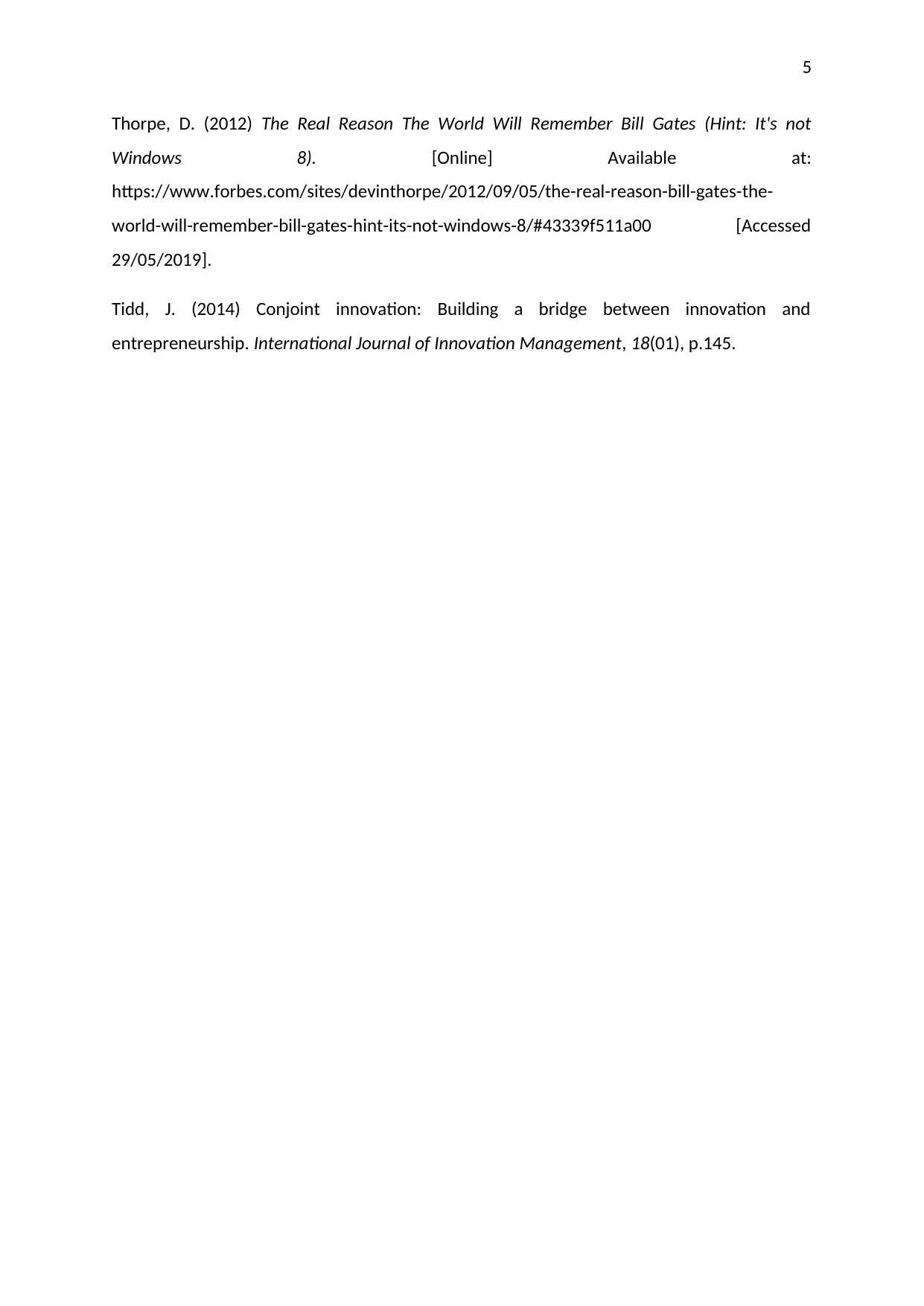
5
Thorpe, D. (2012) The Real Reason The World Will Remember Bill Gates (Hint: It's not
Windows 8). [Online] Available at:
https://www.forbes.com/sites/devinthorpe/2012/09/05/the-real-reason-bill-gates-the-
world-will-remember-bill-gates-hint-its-not-windows-8/#43339f511a00 [Accessed
29/05/2019].
Tidd, J. (2014) Conjoint innovation: Building a bridge between innovation and
entrepreneurship. International Journal of Innovation Management, 18(01), p.145.
Thorpe, D. (2012) The Real Reason The World Will Remember Bill Gates (Hint: It's not
Windows 8). [Online] Available at:
https://www.forbes.com/sites/devinthorpe/2012/09/05/the-real-reason-bill-gates-the-
world-will-remember-bill-gates-hint-its-not-windows-8/#43339f511a00 [Accessed
29/05/2019].
Tidd, J. (2014) Conjoint innovation: Building a bridge between innovation and
entrepreneurship. International Journal of Innovation Management, 18(01), p.145.
⊘ This is a preview!⊘
Do you want full access?
Subscribe today to unlock all pages.

Trusted by 1+ million students worldwide
1 out of 6
Related Documents
Your All-in-One AI-Powered Toolkit for Academic Success.
+13062052269
info@desklib.com
Available 24*7 on WhatsApp / Email
![[object Object]](/_next/static/media/star-bottom.7253800d.svg)
Unlock your academic potential
Copyright © 2020–2025 A2Z Services. All Rights Reserved. Developed and managed by ZUCOL.





